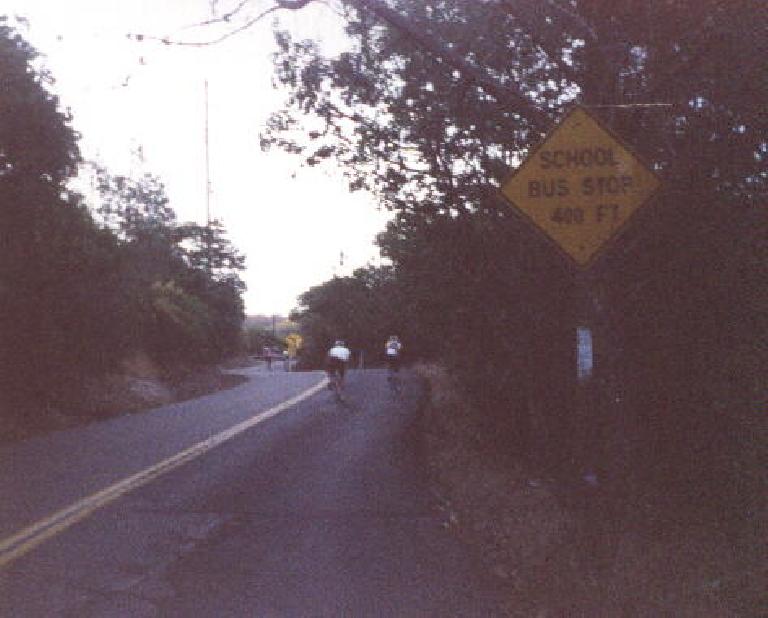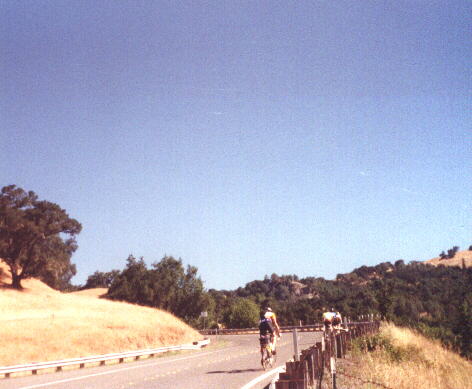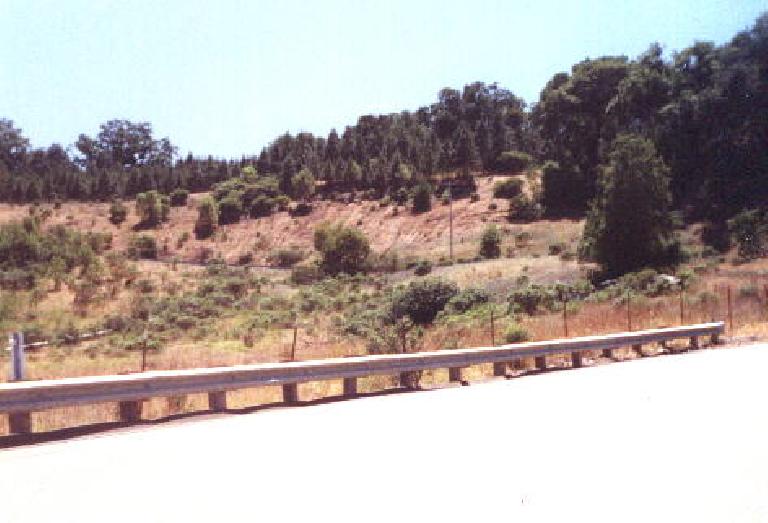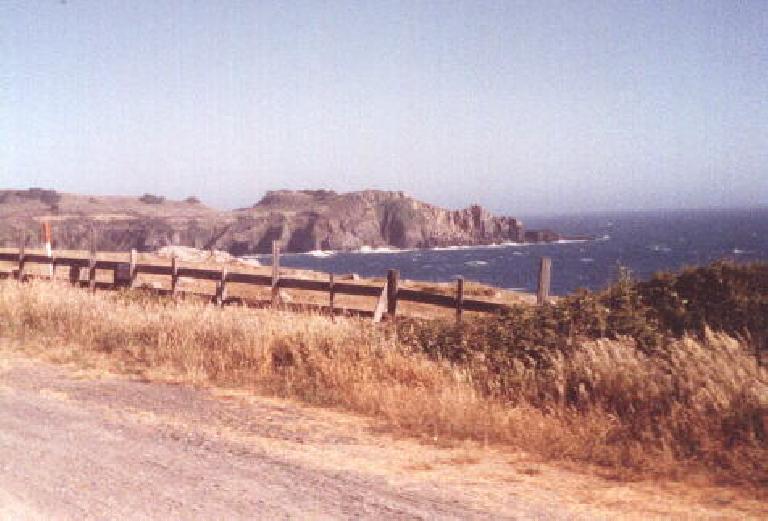Terrible Two Double Century
The Terrible Two was my fifth double century bicycle ride for 1999. This was no normal double. Besides being touted as “the most difficult one-day ride in the U.S.”, it was the third and last event of the California Triple Crown Stage Race. In addition, being the last double held in CA this year, it was my last chance to qualify for the One Thousand Mile Club. All my cycling goals for 1999 were suddenly contingent on this event. The event was also on my birthday.
Climbing its mountains with 16,000 feet of vertical gain in 100 degrees would be a challenge for almost any cyclist, I knew. Hence, I did more training in this year than any other year of my life. In addition, in the weeks prior to the event, I upgraded my Cannondale 3.0‘s components to 9-speed Campagnolo. This included Chorus Ergopower levers, a Racing-T front derailleur, and Veloce rear derailleur. I mated these with a Shimano Ultegra cassette on an Ultegra hub after implementing this Shimano-to-Campagnolo 9-speed cassette-adapting kluge. The new Campy components were far more precise and positive-feeling than the old Shimano 105 ones.
I even managed to borrow a friend’s high-powered bicycle light just for this ride (thanks, Dave). A couple days before the ride I stocked up on Clif bars and Clif shots, a diversion from my usual cereal and granola bars. I tested everything two days before the ride, and thought I was totally prepared. What could go wrong?
Bad News
I woke up the day before the event with a terrible sore throat. I could hardly swallow. Hoping it is just some sort of 24 hour flu, I limped into work, not being able to get much done.
In the mid-morning, our office administrator exclaimed, “Wow, are you sick? You look like you have a fever.”
That definitely was not encouraging. I figured I could ride with cold symptoms, albeit a tad slower, but was less optimistic I could ride with a fever.
So in a quest to make a miraculous 24-hour recovery, I consumed gallons and gallons of fluids, including some great chicken bouillon at work. Then I slept for a few hours at home before waking up at 2:30 a.m. to pack and drive over to the ride. The sore throat and fever actually had subsided somewhat. Off to Santa Rosa in the MG.
The Ride
The First 75 Miles
I arrived at the start of the ride listening to Top Gun music (Highway to the Danger Zone) one whole hour early. I ate a muffin and waited for the pre-ride announcement, which lasted 10 minutes. During this time some people crowded around my Cannondale to admire not only her pretty frame but her new Campy components.
The ride then commenced at 6:30 a.m. I started off the back but moved my way up in the first 20 miles. I could not believe how good I was feeling considering that the day before I felt so miserable.
I was ahead of about 40 people by the time we got to Trinity Grade, the first climb of the day. It was a gradual climb, and I was still feeling okay. Concentrating on maintaining an efficient line and steady strokes, I was at the top of this double summit without exerting too much effort. It really wasn’t too bad.
The descent was glorious. I got into my best aerodynamic tuck, with hands next to the stem and chin practically on top of it. The road was in very good condition with good visibility. I guess I was expecting something much worse considering the warnings from before the ride. But another rider told me the truly terrible roads would come later.
Here I was reminded of why I love bicycling so much: beautiful scenery and wonderful descents. Those feelings were fleeting, however. Over the next couple of hours my body rapidly went into downhill spiral, succumbing to the illness that had taken over me the day before.
Mile 75 to Lunch
After Trinity Grade I rode solo for a while, and then was joined by a rider on a new Cannondale. We exchanged pulls and were going fast. So fast that, after 15 minutes, I am really feeling beat and had to ride solo again. It was clearly not a good idea to be trying to work with this speed demon.
Then a paceline came up, which I joined thinking “less work, more speed.” I was also becoming somewhat concerned of my time splits at this point. Riding solo, I was only going 13-16 mph. My goal was to finish the first 100 miles within 7 hours, and though I was still on pace to do so, I was definitely cutting it close.
It turned out this was not a good paceline to join. This is because of an insufferable old man in it. He frequently screamed rude remarks (such as calling a guy “you jackrabbit” for not maintaining a steady pace at the front), and shouted an obnoxious “SWITCH!” every 45 seconds. He began to really grate on my nerves.
Still, I hung with them for 20 minutes until the first big test of the day: The Geisers. This was a visibly steep climb and completely exposed to the sun. I stopped to remove my arm warmers, only to hear more obscenities from the old man, this time directed at me. I waited until he was well up the road before I mounted back onto my bike. No need to deal with people who need an attitude adjustment when there were other things to worry about.
Such as this climb. I was really dying at this point, and everyone was passing me. It seemed to go on forever and yet I had nothing in my legs. I didn’t even have the energy to reach down for a water bottle anymore.
Psychologically I was suffering, too. The official time limit of 16.5 hours was like a monkey on the back, and reaching my goal of the first 100 miles in 7 hours was quickly slipping away. I was going only 6-8 mph up this hill, and was getting dropped by everyone. And where was the end of the climb?
When the seventh hour does come I was at only Mile 90. I was somewhat seriously considering abandoning the entire ride now, feeling sick, tired, and demoralized. Yet, something kept me going, if barely. I have never abandoned an ultra-marathon ride in my life. I resolved that if I were to not finish the ride, it would have to be because the ride organizers kicked me off the course later in the day for being out too late, not because I was a quitter. So I reluctantly carried on.
All I could think about was getting to lunch, and trying to recuperate as much as I could over there. I was dehydrated by this point, but despite not having drunk too much, I was nearly out of water. I also felt that the Clif Bars, Clif Shots, and Revenge Energy Drink (which I tried at a previous rest stop and even made the mistake of filling up one of my bottles with; it was disgusting) only compounded the dehydration problem. Those “energy” foods were extremely dense with carbohydrates and required lots of additional water to go down with them. I resolved that I would use only water and “real food” such as cookies and cake for the rest of the ride, and perhaps all future rides as well.
Not too long afterward, some cyclists heading the other way shouted, “You’re almost to lunch; just a few more miles!” Indeed, just a few miles up was the park where lunch was supposed to be at. But where was it?
Another cyclist and I looked for about 5 minutes, after which we realized it was a quarter of a mile further. I wished signs were posted better. Anyhow, at lunch, I chucked two water bottles in order to fend off the effects of dehydration. Ten minutes later, I got going again.
Lunch to the Pacific
Thinking that the route went the way the cheering cyclists were going 15 minutes earlier, I started heading the wrong way. I got a mile out when it dawned on me this was not the way to go and headed back to lunch. This had the dismal effect of tacking on ten minutes and two more miles to the ride. I was quite bitter at the cyclists who were encouraging me, whom I mistakenly thought were doing the ride also. It turned out they were doing another ride with their local bike club and just happened to know that the Terrible Two was going on. I felt misled by them, even though they had done nothing wrong. The pressures of time and being sick did not do anything positive for my attitude.
On the way back through lunch, I chucked down yet another water bottle. Everyone at this point was talking about Skaggs, the double-summit climb ahead, including how steep and how hot it was, being unshaded practically the entire way. Oh boy.
I started out conservatively, and actually was not feeling so bad anymore. So maybe the doom-like feelings were mostly caused by dehydration after all, and the three water bottles I drank in the last 20 minutes had cured this. I was even passing people, although I stop SAG vehicles at just about every opportunity to top off my water bottles. It was hot, probably about 90 degrees, but not totally unbearable.
And soon… a long descent. Aero-tuck time. Again, I stopped off at a another water stop, where one of the hostesses remarked how alive and strong I was looking there, not even being sweaty. I replied that I was indeed super sweaty, but the descent had cooled me off. But I was indeed feeling pretty well at that point.
Alas, this would be the last time until eight hours later that I did feel pretty decent still. Another killer double summit was ahead–one that was shaded–but was so steep I was totally dying on it.
One-point-seven mph! If I had any other cyclometer besides an Avocet, this low speed would not have even registered. Yet, I was barely turning the pedals in the 32 X 23 lowest gear and was going a mere 33-minute-mile pace. Not surprisingly, then, the climb took me 1.5 hours. I could have been walking faster, but ego forbid me to walk. I might have been sick, I might have been slow, but I haven’t walked on a ride for a couple of years, and I just didn’t want my last double century for 1999 to end up that way.
It was on this climb, however, I conceded my chance for finishing within the 16.5-hour official time limit was entirely gone. My new goal was to get to the last rest stop before 10:00 p.m. so I would be allowed to finish the ride, even if I wouldn’t get the T-shirt. Even that goal was becoming something of a long shot. The climb was hard, humbling. But I kept on going.
Finally, hours later, I reached the Pacific. The winds were favorable and there seemed to be a gradual descent. Yet, I was totally dead at this point. In these conditions with a healthy body I probably would have been going at least 23 mph, but I was coasting most of the way and struggled to maintain 13 mph. A lady in her 50s caught up to me and asked if we could trade pulls. I replied, “No, I’m really dying,” to the dismay of both of us, so she headed up the road alone. Once again I was too tired to drink, despite stopping three times to take a leak at the side of the road. My body had finally given out.
At last, the rest stop at Fort Ross was in sight at 7:00 p.m. Only a few people were there. The older woman who passed me half an hour earlier was still there, bemoaning how hard the ride was. We were also told about the next, and final, double-summit climb: Fort Ross Rd. She looked at me and asked, “What are we going to do?”
I mutter, “I’m going up it… just very slowly… probably at 1.7 mph like on the last climb.” The lady replied, “I walked up that one!” We lamented the toughness of these climbs together. There was a crucial difference in our attitudes, however. I already decided I was going to keep on riding until I got kicked off the course, and wasn’t going to give it a second thought about climbing whatever Mother Nature threw at me. On the other hand, she dwelled upon how hard it is for a 50-year-old woman to be doing these types of rides, and was openly considering quitting. She stayed behind while I took off on my own.
Fort Ross to the Last Rest Stop
The climb up Fort Ross started right away. Surprisingly, I was going well over 1.7 mph—about 6 mph. I was feeling a bit better after the rest stop. I even caught up to another cyclist.
Such energy was short-lived, but I was still well enough to keep going without suffering too much. A pair of women passed, and though I let them quickly get an eighth of a mile ahead, I kept pace. It was starting to get dark.
I got over the first of the double summit and hoped the second summit wasn’t too bad. I kept telling myself “last one of the day” to lift my spirits, and it seemed to work. Second summit achieved.
By this time the women who had passed me were long gone, and the sun was rapidly going down. Most of the rest of the ride was mostly descending, but the roads were poorly maintained. There were hairpin corners all over the place, too. So even here I did not make up much time. Finally, I forced myself to become more aggressive in the downhills and take the best lines. Still, I was braking a lot.
I was so relieved when I was out of the hills, even though it meant I wouldn’t have many more descents. There were only 10 more miles to the last rest stop and an hour-and-a-half before it closed. At this point I was pretty sure I could make it.
Knowing it wasn’t a certain thing, I again forced myself to ride more aggressively. I was especially feeling apprehensive that it was getting dark, and my lights were at the rest stop ahead. I remember the Central Coast Double Century earlier this year when I lost at least 45 minutes due to not having good lights. Thank goodness at this time of year the daylight hours were at a maximum, with the sun being fully down only until 9:15 p.m., but I resigned to the fact that I would be riding in total darkness for at least ten minutes.
That prediction turned out to be correct and at 9:30 p.m. I saw the rest stop. Woot! I made it before the 10:00 p.m. cutoff. So though finishing within the 16.5-hour cutoff was entirely out of grasp, I would finish the ride at least. Completing the Stage Race and qualifying for the One Thousand Mile Club was going to become a reality!
To the Finish
I hung around with other riders for the next half hour, chatting and reveling in the fact that we had gotten to the last rest stop in time to finish the ride. I was now full of energy and euphoric, recounting how I was so sick the day before, how important finishing this ride was to fulfill my cycling goals for the year, and how it was my birthday. I felt victorious for getting so far under the circumstances. There were still 15 miles to go. But those miles were anticlimactic.
The last people coming into the rest stop—four of them, including a husband and wife couple—were very nice and we had some good laughs while we picked up and mounted lights for the last leg of this brutal ride. They were a huge contrast to the attitude-challenged guys from earlier in the day. We rode the last leg together, the final group.
The last 15 miles felt like the final stage of the Tour de France–a big celebration and mostly a cruise to the finish. I had cycling legs again—maybe not of normal strength, but adequate ones. And the high-powered Trek bike light–the first light I’ve ever used on an ultra-marathon ride other than my wimpy two-watt VistaLight headlight–was amazing. Thanks, Dave, for lending it to me. These were the brightest lights so I rode at the front, lighting everyone’s way.
By 11:10 p.m., the job was done and we rolled into the high school parking lot with virtually no one there. We were definitely the very last group to come in. Dinner was already being packed away, and we grabbed whatever food we could.
Despite the struggle and suffering of it all, this felt like a hard-earned victory, one that was made even more gratifying on my birthday than if everything had gone entirely smoothly. No, when I do the ride again I’d rather not be sick, but looking back I am thankful that I wasn’t so sick that I couldn’t do the ride at all.
I will do the ride again someday, probably next year. The 16.5-hour time goal was elusive this year, but it left an ultra-marathon goal still hanging out there. A reason to carry on, to cycle more miles. I can’t wait.
Postscript
Years later, I received confirmation that I was the youngest person to complete the California Triple Crown Stage Race up to that point by finishing this ride. The Terrible Two was the third stage of that series of California’s most difficult double centuries. It was nice to fulfill that on my 24th birthday.
Ride Data
- 200 mi.
- 5:30 a.m. start, 11:10 p.m. finish—17:40 hours
- Average Speed: 12.3 mph moving, 11.3 mph overall
- Max Speed: 49.4mph
- Total Climbing: 16,000 ft
Rating
(5=best)
- Scenery: 3+
- Support/Organization: 4
- Food: 4. Well stocked.
- Weather: 3. Generally not bad, but a bit hot on Skaggs Springs
- Relative Difficulty: 5+
- Overall Rating: 4. Deserving of its “most difficult U.S. double” reputation.



